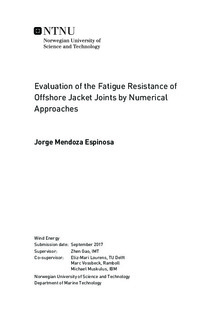| dc.description.abstract | Jacket support structures are a preferred solution for offshore wind turbines in deeper waters. Extensive knowledge exists in relation to its construction technique as well as its crucial components, but due to considerable cost pressure, continued optimization is essential for the future competitiveness of the concept in the offshore wind business. A significant share of the overall production costs of jacket structures is related to the joints connecting the tubular members. Hence, these joints along with their complex welds are of special interest in terms of cost reduction. The design of tubular joints is generally driven by fatigue resistance. Due to the size, complexity and cost of these joints, this is assessed by using detailed FE models.
When defining a numerical model, assumptions have to be made. These decisions influence the obtained output. Several aspects that have an impact on the results of the models are found to require further research and are investigated within this project: (1) influence of using solid versus shell elements in the modelling of the joint members; (2) degree of accuracy of the Efthymiou equations; (3) influence of the carry-over effect in multiplanar KK-joints; (4) differences in the fatigue life predictions between the hot-spot and the effective notch stress methods.
Guidelines recommend the use of both solid and shell theories for the definition of the FE models used in the hot-spot fatigue assessment. Both options are compared in terms of accuracy of the results and computational time. Generally speaking, significant differences are found between both models. The background of the differences is studied.
The employment of the Efthymiou formulae is common in practice. These equations provide the SCF at the locations around the weld where they are found to be maximum. The use of this approach carries two sorts of uncertainty. One is directly related to the values that the equations predict. The second one stems from the lack of information on the results at the other positions around the weld. The output of this approach is compared with the results of numerical models. The validity of its use is quantified.
Offshore wind jacket joints are mainly multiplanar KK-joints. Loading in the braces of one face of the jacket may yield significant carry-over effects on the out-of-plane braces connected to the same joint. A parametric comparison is carried out to study the accuracy of modelling the joint as a planar K-joint. In general, it is found that the carry-over effect cannot be neglected and the assumption is not accurate.
The fatigue assessment of tubular joints by means of the hot-spot method is subjected to several assumptions that limit the optimization of the members. The notch concept is a more realistic method that is presented as an alternative. However, this method is not widely used in engineering practice due to the difficulties in building the numerical model and the high computational requisites. An algorithm to carry out the effective notch stress assessment, based on the sub-modelling technique, is proposed. A comparison of the fatigue life prediction, between the hot-spot and the effective notch methods, is presented. The latter method is found to predict a higher fatigue life for many of the situations tested. Furthermore, since this method allows for a more detailed modelling, the weld profile can also be designed in order to optimize the fatigue resistance. The weld slope is found to have a significant impact on the results. | |

